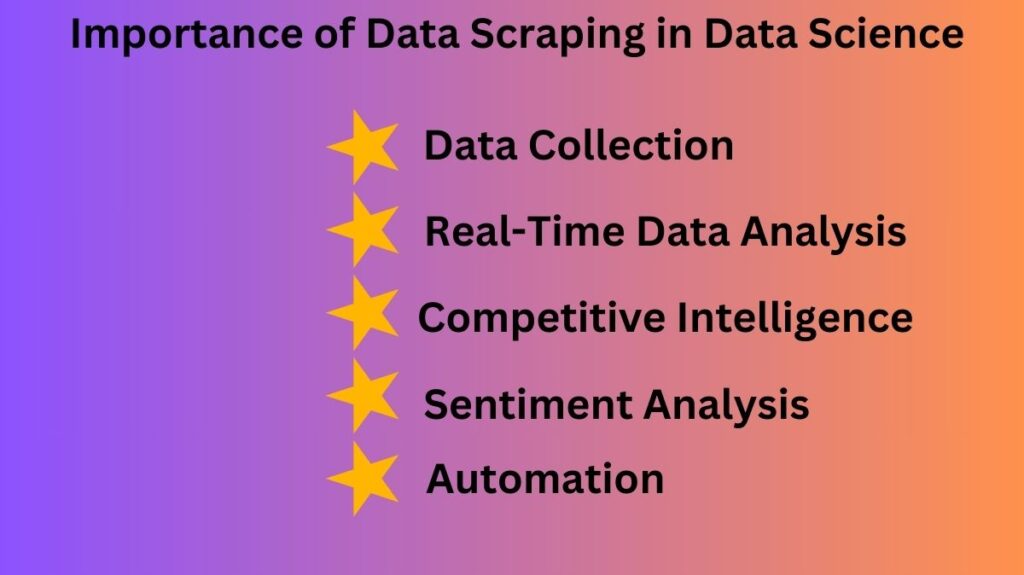Web scraping in data science
Web scraping in data science, is essential in data science. It involves extracting and structuring website data for analysis. With the exponential growth of internet data, data scientists need data scraping to obtain massive amounts of information from numerous web sources. Data scraping, its usefulness in data science, tools and techniques, ethical issues, and potential obstacles are covered in this article.
What is Data scraping?
Web scraping in data science automatically extracts webpage data. Text, photos, videos, and other content can be included. The extracted data is then organized into a CSV file, JSON file, or database for easier analysis and use in various applications.
Web scraping in data science and crawling are different but commonly mistaken. Data scraping extracts specific data from web pages, while data crawling indexes and discovers material. Internet data is often collected and analyzed using both approaches.
The Importance of Data Scraping in Data Science

1. Data Collection
The main way data scientists obtain data is by scraping. Scraping lets data scientists swiftly obtain data from many sources on the internet, which is massive. Market research, trend analysis, and machine learning model training can leverage this data.
2.Real-Time Data Analysis
Data scientists often need real-time or near-real-time data to make choices. Data scraping allows real-time examination of updated website data. E-commerce companies analyze competitors’ prices and change their pricing tactics using data scraping.
3.Competitive Intelligence
Data scraping aids competitive intelligence. Businesses can learn about competitors’ tactics, products, pricing, and customer feedback by scraping their websites. This data can help spot market trends, improve products, and create competitive strategies.
4.Sentiment Analysis
Online forums, social media, and review sites are full of user-generated content. Data scientists can scrape this content and analyze sentiment to determine public opinion about a product, service, or brand. This study can help companies enhance their products and handle user feedback.
5.Automation
Scraping saves time and resources by automating data collecting. Scraping technologies allow data scientists to extract data from websites without manually copying and pasting. They can concentrate on data analysis and model creation with this automation.
Data Scraping Tools and Techniques
1. Web Scraping Libraries
Web scraping modules and frameworks are available in several computer languages. Popular ones include:
Python is the most popular data scraping language due to its simplicity and numerous libraries. Scraping libraries include BeautifulSoup, Scrapy, and Selenium.
- BeautifulSoup: This Python package simplifies HTML and XML parsing. It can navigate and explore the parse tree, making it perfect for web page data extraction.
- Scrapy: Build web crawlers and extract data from websites using Scrapy, a powerful and extensible online scraping platform. Large-scale scraping initiatives benefit from it.
- Selenium: Browser automation tool Selenium scrapes dynamic web pages. It can interact with buttons and forms, making it excellent for scraping user-interactive webpages.
- R: Another popular data research language, R has web scraping packages like rvest and httr.
- Puppeteer and Cheerio are popular JavaScript libraries for scraping dynamic web pages. Puppeteer excels at scraping JavaScript-heavy websites.
2.APIs
Developers can access structured data from many websites using APIs. APIs enable direct data access without HTML parsing, making them more efficient and dependable than scraping. Not all websites offer APIs, and those that do may limit data access.
3.Headless Browsers
Web browsers without a GUI are called headless. Scraping dynamic web pages that load JavaScript material is common. Puppeteer and Selenium can control headless browsers and access page data.
4.Data Scraping
Several data scraping businesses offer pre-built scraping solutions for non-programmers. Users can select data to extract, and these services scrape it. Octoparse, Import.io, and ParseHub are popular data scrapers.
Considerations for Data Scraping Ethics
Website data scraping is powerful, but it has ethical consequences. Important ethical considerations:
Website TOS compliance: Before scraping a website, read its ToS or robots.txt. Some websites’ ToS forbid scraping, and violating them can result in legal action. The root directory’s robots.txt file controls which parts of a website can be browsed and scraped.
Privacy Data:Data scraping may capture sensitive personal information. The General Data Protection Regulation (GDPR) in the EU and the California Consumer Privacy Act (CCPA) in the US must be followed when scraping data. Data scientists should anonymize or aggregate data for privacy.
Rate-limiting: Abuse of a website can overload its servers, causing speed issues or unavailability. Rate limiting website requests can help data scientists prevent this. This protects the website’s resources and decreases the chance of ban.
Credit and Fair Use:If using scraped data for public or commercial reasons, credit the source. Data scientists should also follow fair use guidelines for copyrighted material.
Some modern websites employ JavaScript to load material dynamically, making it challenging to scrape data using old approaches. Headless browsers and Selenium/Puppeteer are needed to scrape such stuff.
Scrapping Prevention:Some websites use CAPTCHAs, IP filtering, and user-agent detection to avoid automated scraping. Overcoming these protections may require complex methods like proxies or switching user agents.
Data Quality:Scraped data may be unorganized and inaccurate. Data scientists must clean and preprocess data before analyzing it. This includes deleting duplicates, missing values, and format standardization.
Legal Risks:Scraping data from websites without authorization can result in litigation and fines. Data scientists must be aware of the legal implications of scraping and comply with relevant laws and regulations.
Conclusion
Data science analyzes and decides using enormous volumes of online data scraped. Data scientists can readily collect data from multiple sources, automate the process, and get important insights with the right tools and methodologies. Scraping data must be ethical and lawful, following website terms of service, data protection, and legal issues. Data scraping helps data scientists reduce risks and challenges.
